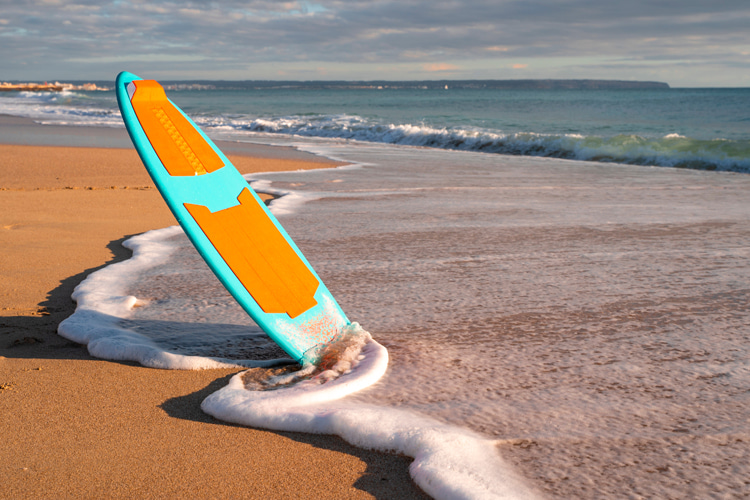Skimboards are board-riding vehicles specifically and technically designed for a particular form of skimming.
Therefore, there isn't really a one-size-fits-all board.
One might be great for some styles of skimboarding, but it may not be optimal for others.
Sure, you could just grab any old board and hit the water, and it will probably move, but its abilities will be limited, and so will yours.
So if you are serious about skimming, you should also be serious about the performance of your board.
The first thing you must determine before you run out and buy a board is what type of skimming you will be doing - and where.
Obviously, this will depend greatly on where you live, but if you plan to travel to other skim spots, you may want to consider a couple of different skimboards.
There are essentially two skimboarding styles: wave skimming and flatland skimming.
At the moment, wave skimming is by far the most popular, especially in the media, but flatland is quickly catching up.
Neither is better than the other; it's just your preference. Wave riding is similar to surfing, while flatland is more like skateboarding.
Once you determine what style of skimboarding you will do, you will know what type of skimboard you will need.
As there are two styles of skimboarding, there are also two styles of skimboards.
Foam Skimboards
Foam skimboards, also known as foamies, are the most technical and expensive skimboards. These boards are made specifically for wave skimming.
Many different shapes and styles have been tried throughout the years, and now they have been narrowed down to just a few shapes that are optimal for this type of skimming.
You won't see a lot of variation in shape, but there are still many other variable factors.
Even though they are called foamies because of their foam core, they are also made from various materials, including fiberglass or carbon fiber and resin.
The materials used to make these boards affect the weight, speed, and flexibility of the board.
Of course, every skimmer, no matter what level, has their own personal preference, but there are recommendations to consider based on your ability.
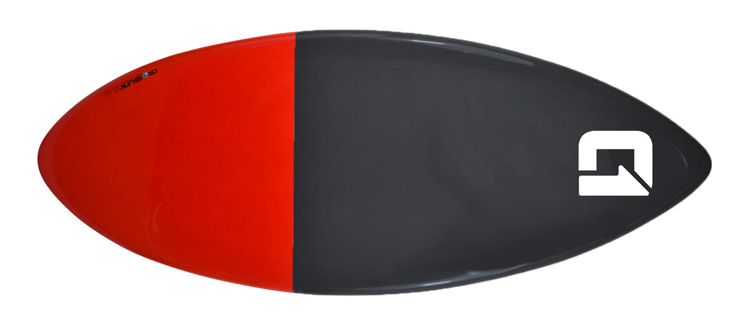
Wooden Skimboards
Wooden skimboards, also known as woodies, are obviously made out of different types of wood.
They are designed for flatland or inland skimboarding and are an excellent choice for sandy beaches and sliding on rails.
Wooden skimboards are considerably heavier and thinner than foamies, so they're surely not suitable for waves.
Just as woodies don't perform well in waves, foamies are not durable enough for flatland and rails.
Wooden skimboards also come in a wide variety of shapes, weights, lengths, and rockers. This is because flatland skimming is very diverse.
The style of board that is best for you will depend on how you want to skim.
Do you want to glide far and fast?
If so, then you will want a longer, thinner - both in thickness and width - board with minimal rocker and side rails that curve down.
A board like this shouldn't be "poppy" because that will slow you down, but it will cut fast through the water.
Or do you want to mostly do tricks and hit up rails?
Then, you would want a shorter, thicker, and wider board with lots of rocker. Rocker is what makes a board "pop," which is what you need for tricks.
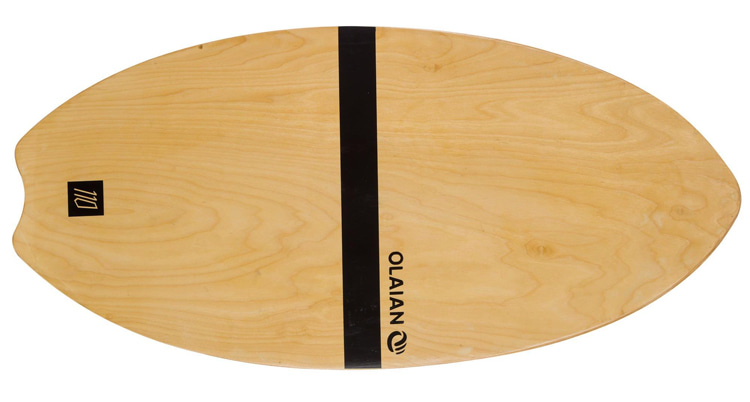
Skimboard Features
When choosing a skimboard, whether woody or foamie, there are a few main characteristics you will need to consider.
And no, it has nothing to do with who rides what - just because your favorite skimmer rides one brand/style, it doesn't mean that will be the right board for you.
Like everything else, the importance of the following factors will depend on the type of skimboarding you will do and your skim level.
1. Skimboard Size
Determining the right size for you can be a tough decision, but it doesn't have to be a complicated math problem.
First things first.
Longer boards are faster; shorter boards are slower. Wider boards are also faster; narrow boards are slower.
Why is that?
The more surface area the board covers, the more water it has contact with and the more push it gets.
So does this mean that you should go out and get the biggest board possible? Not at all. In fact, it is quite the opposite.
While speed is the desired quality, it is maneuverability that is usually highly coveted.
Bigger boards are more difficult to move, while smaller boards are quick to react.
Bigger boards can get you out to bigger, farther waves; smaller boards will get you to the smaller, closer shore breaks.
Next, examine how fast you run.
Obviously, if you run faster, you can get away with a smaller board.
On the other end, the slower you run, the faster (that is bigger) your board needs to be.
Be honest with yourself. Nobody cares, but your riding performance will suffer if you pretend to be something you're not - or at least not yet.
Some people even prefer to run slower, so they expend less energy and ride longer. It's your call.
Now that you have an idea of bigger versus smaller skimboards, let's look at your height and weight - don't worry, no one's judging.
Most skimboard companies have a weight/height range recommendation for their board sizes, and for the most part, they are very reasonable.
But their sizing is very broad to cover a wide range of skimming conditions and styles.
So you might find yourself in a couple of size ranges. So then what?
Well, take into consideration everything we have just gone over and keep reading the rest of the skimboard characteristics.
It'll do you good and maybe save you money in the long run.
Once you have all the information and an idea of what/where/how you'll be skimming, you should be able to determine which size category is most appropriate for you.
The bottom line is: go with the smallest board that fits with your height and weight range, that you can easily handle, and will get you out to the waves you want to hit with enough speed or do the tricks you want with minimal effort.
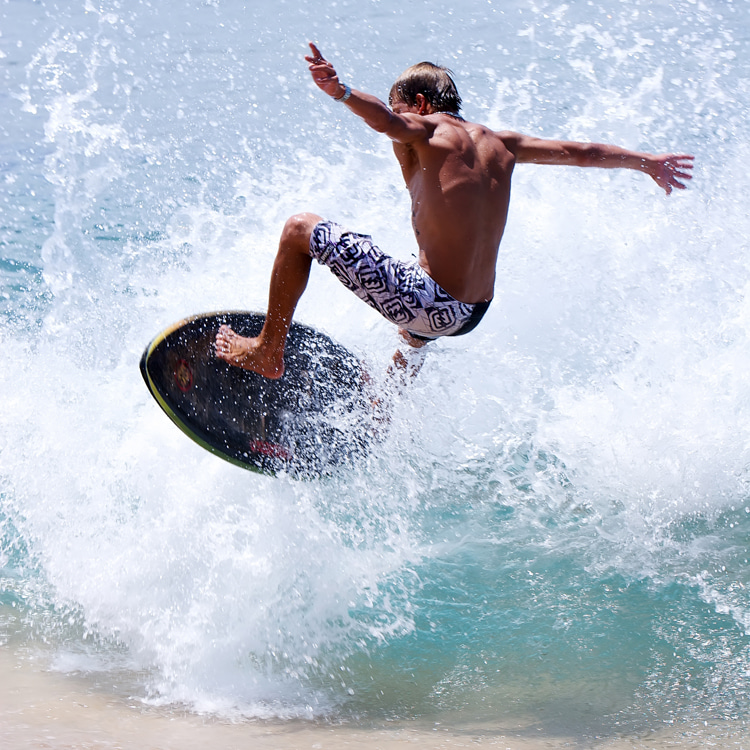
2. Speed vs. Maneuverability
Speed is usually the desired feature in skimboards, but not so much that maneuverability is compromised.
Wave skimmers need speed to get to the desired wave, or they will miss it completely.
Flatland skimmers want speed to ride far and fast with lots of power for tricks and to get over rails.
Speed is more important with wave skimming, so foam boards are the fastest.
Usually longer, wider boards are the fastest, but they are very difficult to move quickly, so the rider would mainly stick to nice, smooth, soul-surfer-style carves (and maybe that's what you're after).
Short, narrow boards are slower, but they are very responsive, making them ideal for executing sharp, quick tricks.
Neither one is better than the other; just make sure to make your selection based on your preferred skim style.
If you are just learning to skim, stick to a bigger board to start with.
It will get you out to more waves - that's more rides for you - and provides more stability, i.e., less bailing.
If you are more advanced and capable of getting out to the desired waves easily, maybe it's time to start thinking about a smaller board.
Now, let's throw a wrench in everything we've covered above.
With regard to wave skimming, there is another consideration. Bigger, faster, more powerful waves will give you lots of speed. Smaller, weaker waves won't.
So here is where the above advice differs a little.
If you want to go faster in small, weak waves, go for a slightly bigger board, or you'll never even get to it.
Naturally, if you're in a spot where you can hit a big, powerful wave, go for a slightly smaller board that maneuvers better because you already have the speed.
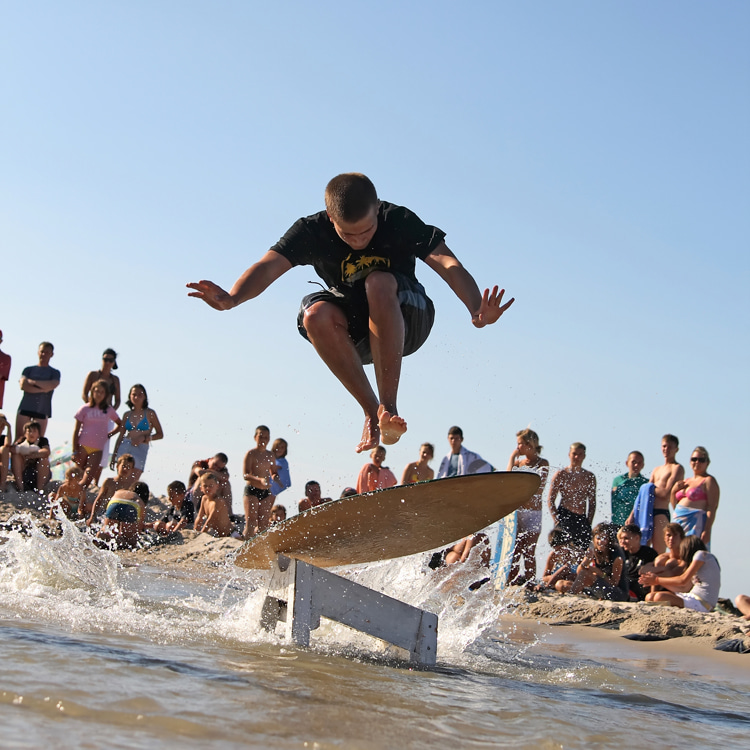
3. Rocker
Rocker is a characteristic that often translates into pop.
There is quite a lot of variety in rocker and, again, it really depends on what you want to do and where you want to skim, but in the end, it comes down to personal preference.
Most wooden boards curve up equally at each end so that both the nose and the tail kick up like a skateboard.
This also creates a very "poppy" - or bouncy - skimboard, making it ideal for tricks.
Foam boards tend to curve up a lot at the nose and just very slightly at the tail.
This allows the rider to cut easily through the water with good control. The degree of this curve varies.
The greater the rocker, the slower the board is, but it will react better. Less rocker means a faster board, but responsiveness is sacrificed.
4. Weight
Skimboards must be light enough to practically float - or skim on the water - but heavy enough that they don't fly away in the wind.
Lighter boards are better for waves, so they glide far and fast without sinking, while heavier boards are preferred for flatland as they are more durable and easier to control.
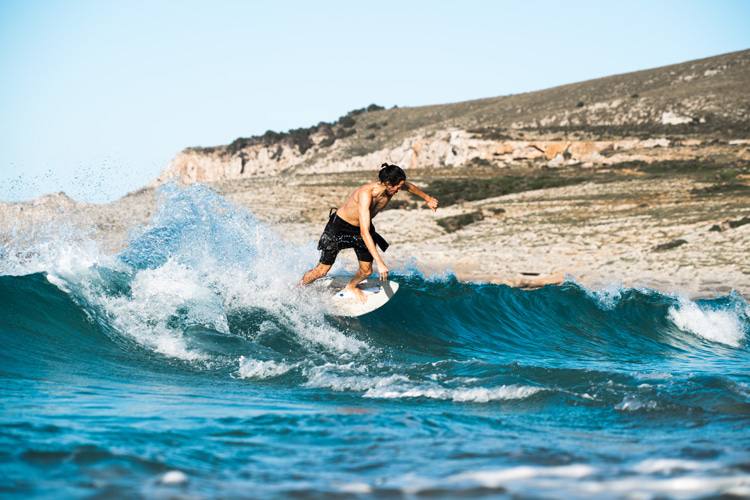
5. Flexibility
Slightly flexible skimboards are less prone to snapping than stiff boards, but they are slower, whereas stiffer skimboards can cut super fast through the water but can be rather sensitive to snapping.
Again, this is mainly a personal preference based on your riding level and style.
In the end, it's highly recommended that you check out online forums, get out skimming with other skimmers, ask lots of questions, and try all sorts of different skimboards before you make a decision.
Find out what you like and don't like.
There's nothing worse than spending a lot of money on a new stick only to find out after riding it that you don't like it.
Once you've considered all the factors above, it really comes down to personal preference and riding style, so if you don't already know, find out what that is before making a decision.
Last but not least- do you think you've got the skills to make your own stick?
If so, here are some step-by-step instructions and various ways to make either a wooden or a foamie skimboard.
Words by Nicole Rigler | Skimboarder
